Text
Critical Annotation
In my third semester of the MFA program, I continued my thinking about memory from the previous semester, which led to this semester's research on the themes of nostalgia and collecting.
In this project, I explore the themes of collecting and personal life situations through the creation of computer-generated images, particularly in relation to childhood and insecurity about an unknown future. The absence of the figure in the work increases the sense of detachment of the work. Reacting to the marginalization of children and the sense of social alienation of individuals.
Through computer-generated images, I combine toys and specimen bottles to express the concept of non-contact and the contradictory behavior of adults who want to preserve the child's mind while trying to delete the child's thoughts.
Out of creating the blog as a storage, I sought out as well as compiled artists who influenced me and analyzed their work in comparison to my own. I searched and organized mainly according to the different parts of my project
The first is the work of Mike Kelley, who interprets the concept of toys, and Marcel Mauss' The Gift, which refers to theories about gifts, as well as Mark Nixon's extensive photography of real toys, which has led me to ask about the different meanings of toys for adults and children, and how our attitudes toward toys change as we grow up. and the changing attitudes toward toys.
Second, the taxidermy bottle as a container for toys, a paradoxical element that both protects and prohibits touching, is also used in Damien Hirst's work as an example of glass. This transparent material can express invisible hindrances.
I also collected the contrasting relationship between specimen and container in Julia deVille's work, and I illustrated my interest in the advantages of digital modeling in model making in the case of Angry Woebots.
The collection and storage of the Internet as a reference also fit the theme of my "collection" and I gained satisfaction in putting them together.
0 notes
Text
Mike Kelley
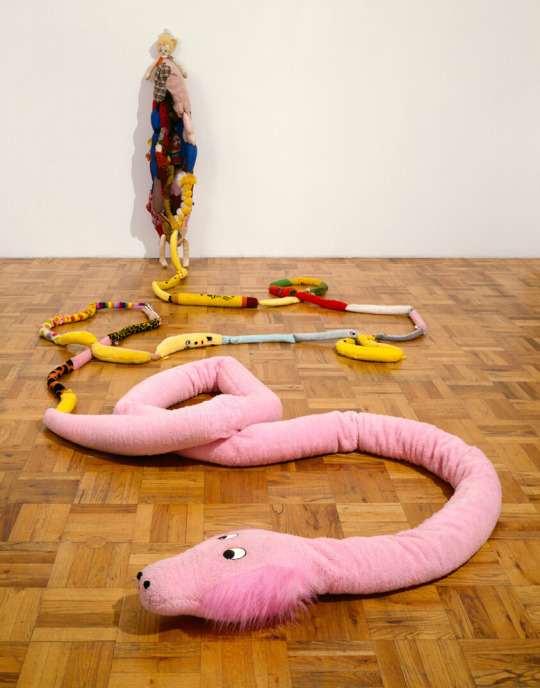
In Kelley's interview, he invokes the toy as a currency that represents emotion, the doll suggests the concept of an abstract unit, and the handmade toy becomes a debt without a price, acting as a counterpoint, a gift, or a monetary token that articulates a wide range of relationships. This is very different from the derivation of toys in Kelley's work, but they both use the figure of the toy as a symbol of the emotion conveyed in the work.
In Marcel Mauss's The Gift there is a reference to the theory that gifts should be returned, and in greater numbers, so they order society by creating a constantly renewed relationship of obligation. This implies the identity of the gift as spirit. The gift received is part of the 'soul' of the giver, so even if it is passed on to another party, any payment or love received from the latter is part of the gift and must be returned again to the original donor. In other words, "what is given is not without effect," but is part of a complex, multi-layered system of moral and spiritual exchange.
At the same time Kelley's elaboration of the negative connotations of toys led me to consider whether nostalgia is mixed with negative emotions, i.e. the compulsive collection, storage, and prohibition of touch, making the search for alternatives to childhood memories a pathological emotional compensation. And when we retrieve a memory, when we actually think about the past, we actually change the memory slightly, each time we recall it in our brain and remember it, and then put it back. It actually differs from what happened before. As a result, the remembered item gradually becomes deviated from the initial image, and can get further and further away from the initial version, which makes the collection prompted by nostalgia never fully satisfied, and the recreation for the remembered item evolves into repeatedly recreating what is most purely wanted to be remembered. At the same time, the act of making replicas based on memorized objects is similar to the mass production of handmade objects, which are becoming more and more personal from the original handmade toys made by others.
Eviscerated CorpseDate:
1989
0 notes
Text
Mark Nixon
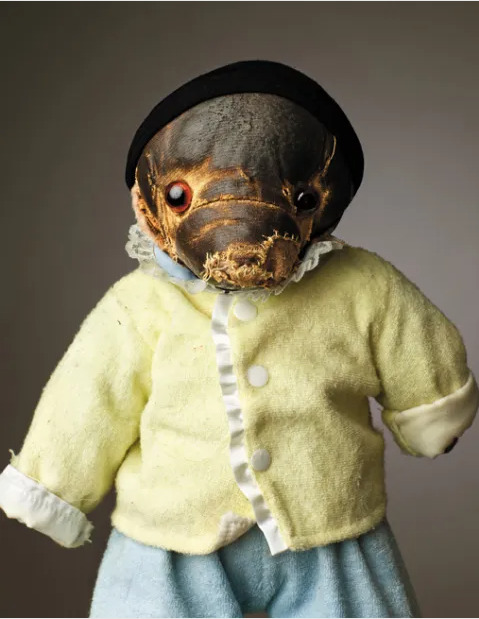
The idea that children's ideas are ignored in the making of toys is a form of child marginalization, where children are marginalized and become more protective as they get older. It is a protection of the concept of childhood. While touch is a prerequisite for play, the isolation of the toys in the specimen jar makes this a paradoxical act of both preserving and removing the child's heart, and the toys in the jar become a distorted substitute. Related to this project, though, is the fact that stuffed toys are transitional objects for children.
Many of the stuffed toys featured in Mark Nixon's Much Loved are provided by adults, and many of the stuffed toys he photographs are over 40 years old. The symbol of "adulthood" is gradually and inevitably replacing it….
The taxidermy bottle, as a much repeated element of my work, I wanted to express the repetitive nature of the act of collecting, and Kathleen Stuart argues that nostalgia can be seen as a limiting activity, where we bind ourselves to a recreation of the past, trying to fill the void created by the collapse of a sense of place and history. I think this articulates a causal relationship between emotion and behavior, where nostalgia leads us to different levels of collecting behavior, where we find similar objects in our memories and preserve them as facsimiles of the toys in our memories, creating our own personal collecting space where we can relive the past and thus escape the unknown outside world and an uncertain future.
Teddy Moore
Age: 43
Height: 14 inches
Belongs to: Daragh O'Shea
(© Mark Nixon courtesy of Abrams Image)
0 notes
Text
Angry Woebots

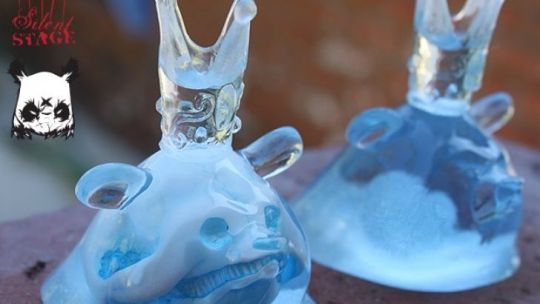
Angry Woebots makes toys through the 3D medium and painting, his signature character is the panda who shows stress, anger and emotional states, not the usual emotions we associate with pandas, the artist tends to convey stories of struggle through them. There is a great deal of hip-hop, punk rock, graffiti and other new art forms involved in his work.
His work repeatedly reminds me of the blind box, a small, hot-selling toy that primarily sells design, a toy that has studied the consumer's collector's mentality and desire to raffle off a prize and collect a complete set. This is the same as the Angry Woebots work shows, a collection of new elements, and graffiti is the most eye-catching.
And the use of 3d modeling for toy design is also the same as I use modeling software to generate toy 3d models, which is very convenient way, you can make a realistic model on the computer in advance, and then modify according to the preview effect, and finally make a lot of production, which will be a great money-saving time. I also realized this in my work, although I just started to learn modeling, this kind of production by digital, very close to reality, and even give the illusion that you are looking at real objects. Unlike the work of Angry Woebots I do not use any trendy elements, my toys look old and colorless because for me toys are not something to be sold to others, but my personal property, which is full of memories and irretrievable time. This may also come from the different positions between us, the maker and the collector of toys.
Angry Woebots for STGCC 2013
0 notes
Text
Julia deVille
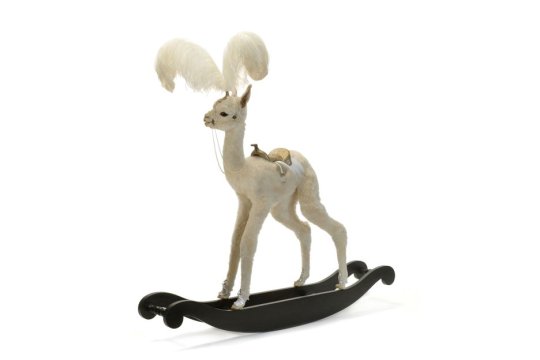
In her work, the art of taxidermy is combined with jewelry in order to find a balance between sadness, humor, and realism. Natural creations are combined with man-made luxuries, through taxidermy, where life is transformed into artifacts in equal measure and animals are preserved in a morbid way, demonstrating the contradiction between a sense of morality and aesthetics. Yet her work gives me the illusion that this is a grand banquet, contemplating the causes and necessity of this sense of back morality on the scale of creatures as food. She puts the young animals there and does not painfully succumb to their death, which occurs in the abstract. She combines natural beauty, ornamental, sentimental and gastronomic language to make us think about the aesthetic economy, and the structure and foundations of luxury. As well as the fact that luxury, although envied and competitively cultivated by all developed economies, has been criticized.
It prompts reflection on what I do not produce when making toy specimens, a moral sense of violation that results from the inanimate properties of toys and the way they are made using modeling, but the contradiction between conservation and access that my work produces. and the concept of excess in a large number of handmade toys that are imitations of the original template toys. In contrast to the notion of luxury, my direction is more personal, a secretive and secretive collection, where toy collecting is as much a collector's item as a luxury item, but without the strong purpose of outward display, but rather an inward, purely personal collection for self-satisfaction.
Julia deVille, Rocking Alpaca 2014.
0 notes
Text
Damien Hirst
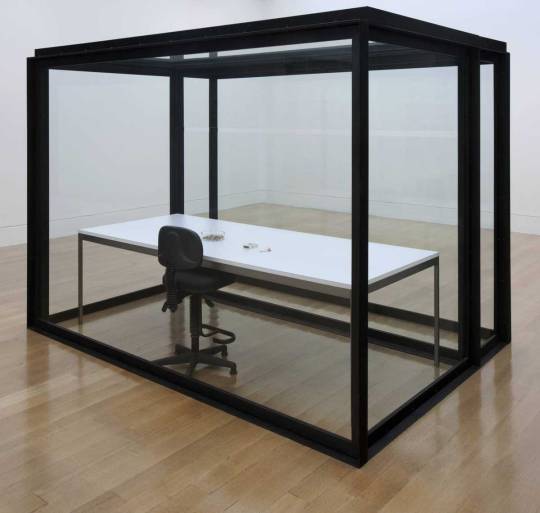
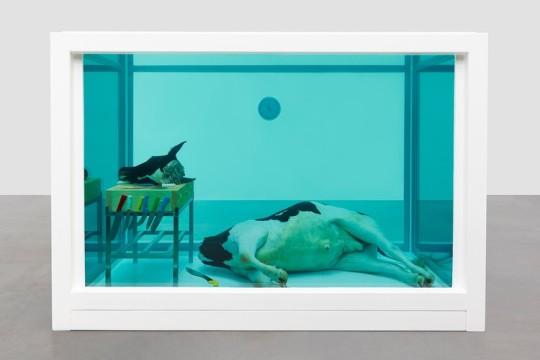
The implied contradiction between the pursuit of knowledge and life is reflected in Damien Hirst's series "Forms Without Life", where there is a strong irony in the loss of life that inevitably occurs when scientific studies such as autopsies are performed on cadavers. Creatures are added to Damien Hirst's artworks to express their emotions with artworks, and this essay reverses this relationship by interpreting human emotions in light of artworks. The author of this essay discusses Damien Hirst's work, which is creative and explores the various ways in which emotions are expressed in artworks, such as DH's use of literal parody to express emotions, the use of verbal symbols, the use of real objects (flies and sugar), to stimulate a faster and more immediate emotional response from the viewer.
The article provides a precise description of the emotions discussed through a more theoretical and scientific approach, using theories about emotion - a specific individual's organized knowledge of what emotion is and how it works (Smith 1995) - and I began to think about the use of pictorial symbols in relatively objective language, subjective emotion. My art making is usually personal, and I should strive to understand what the work looks like in the viewer's mind, or whether the work resonates with the viewer. Although aesthetic experience is generally considered highly subjective, we can strive to understand the nature of aesthetic levels and judgments, just as literary critics do in order to judge works as objectively as possible. Of course, different people will behave differently when they are exposed to a work of art in different contexts. This work made me consider how best to convey my emotions. In many of Damien Hirst's works on death, the lifelike corpse becomes poetic with its title, and the viewer can pass through the middle, while death itself is a constant topic in philosophy and science. Death itself is an eternal topic in philosophy and science that applies to everyone and causes everyone to think.
Hirst's work deals with the dilemmas of human existence, including the fragility of life and society's reluctance to face death. A desk and chair are enclosed in a steel-framed glass case or cell. On the desk are a pack of cigarettes, a lighter and an ashtray. According to Hirst, the cigarettes are associated with the cyclical nature of life, with the cigarettes representing life and the ashtray representing death. The inevitability of death is also evoked by the trap suggested by the title and confirmed by the closed glass outer frame.
Much of my inspiration comes from Damien Hirst's interpretation of death and his allegory of the elements of the installation in his work, such as the glass that reminds him of claustrophobia and the cracks in it as an outlet for his thoughts. Hirst's glass window aesthetic references the sculptural forms of the American Minimalists, and the simplicity and clarity of this exhibition-cabinet-like approach appeals to me, and in my work I interpret glass as a kind of default rejection and protection.
Damien Hirst
The Acquired Inability to Escape (1991)
1 note
·
View note
Text
Polly Morgan
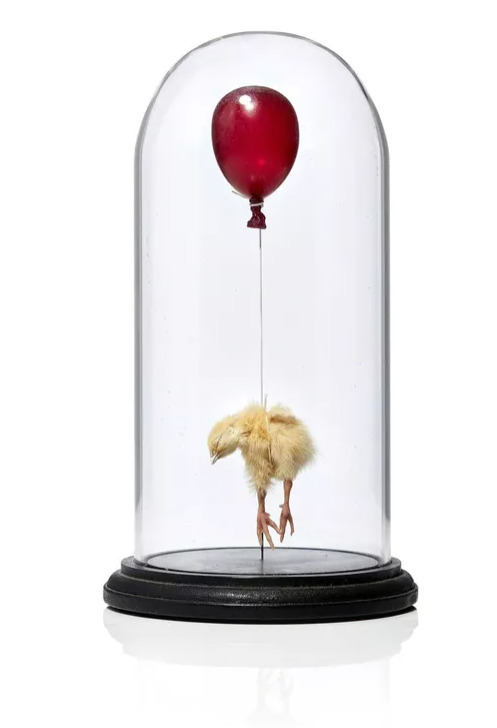
Polly Morgan uses creepy language, such as a rotting tree that has fallen on its side.7 Piglets are sucking on the trunk from the branches below, the sap running down their chins like milk. Penis-pink mushrooms are growing out of the lobes of the bark and then being eaten by birds. Next to them is a dead deer, hollowed out from the inside, and some cremated birds, their nests coated with ashes. In works large and small, Morgan arranges animals in realistic and fantastical compositions. One series features snakes twisted into elegant, almost unrecognizable knots.
In another, Morgan pays homage to the exquisite beauty of birds. Miniature baroque chandeliers suspended beneath bell shades illuminate the perfectly aligned tiny bodies of blue tits and chicks. In contrast to the scientific realism of Damien Hirst's formaldehyde animal sculptures, Morgan employs abstraction and romanticism to communicate stories about the subjects she once lived.
Still Birth (Red), 2010
Glass, wood, resin, taxidermy, steel
2 notes
·
View notes
Text
Sarah Sze
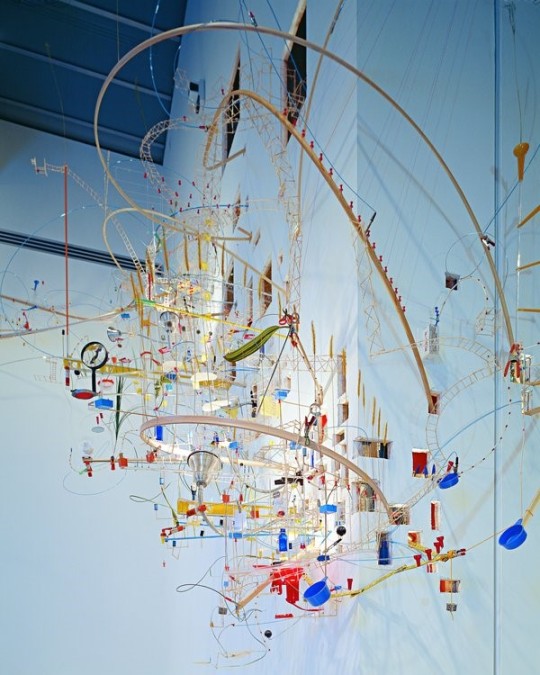
The work includes functional, human objects, such as ladders and buckets. Other handmade elements, such as a small bridge made of matchsticks, used by Sarah Sze include inexpensive, everyday objects that connect the work to contemporary consumer culture. Its structure and shape relate to constructivist, abstract art that reflects the modern industrial world. Using proportions associated with fictional miniature worlds, the spiral structures also suggest the microscopic scale of molecular science. They resemble the double helix shape of DNA, the molecule that determines the growth and reproduction of all living things.
Sarah Sze uses almost worthless things - common, mass-produced, easily accessible, easily replaceable - and puts them in a position to make and juxtapose them in ways that they seem valuable, which gives them a strong translation.
What I make in my own work also creates essentially everyday objects, such as tables and chairs, miniature models made using inexpensive wood panels, elements that have relevance to the everyday objects, miniature worlds, etc. in Sarah Sze's work. But my work is more realistic and I am trying to generalize them better and learn to use a more abstract approach.
Sarah Sze Seamless 1999 © Sarah Sze
1 note
·
View note
Text
Lou Hubbard

Lou Hubbard's work encompasses painting, sculpture, and moving image; sometimes she films her operations, and the resulting video is projected onto the sculptural elements, while on other occasions the sculptures-appropriate, measured, and precariously balanced-are simply outings of their own. In her practice, she uses a raw and refined approach, rejecting any tendency toward embellishment or artifice; the end effect of her work can be perversely humorous or strangely sentimental. This is what I have been considering in adding video elements to my work (they are always exported in image format); the instability that video brings can break the original sense of stability.
In addition to the urge to make things perform, Lou Hubbard shows a love of dissonance and mystery. If her installations turn to forms of irresistible symbolic violence, they are simultaneously undermined by the trappings of humor …… Cartoonish characters and kitschy bibles reduce the various scenes of brutality, infusing them with an unexpected lightness that is another expression of the work's discordant tension.
Lou Hubbard, Dead Still Standing, 2015, Rubber horse, polystyrene, Coalbrookdale outdoor furniture, acrylic dog & leash, skateboard
0 notes
Text
Chiharu Shiota

Chiharu Shiota specializes in the use of large-scale installations and performance art. Her works explore and investigate the issues of life, death and human relationships. Through large linear installations, she explores human existence in different dimensions. These installations often begin with a large, visually striking image that captures the viewer's attention, a moving, poetic large-scale environment, followed by smaller elements within it that enable the viewer to engage in sustained reflection.
In Chiharu Shiota's work, there are often many everyday objects, such as suitcases and shoes, and then Chiharu Shiota uses thread as a link between the objects. Most of her work is autobiographical in nature, her work is an expression of her feelings and inner struggles, her work is a physical and emotional experience, and as she uses her work to bring out her emotions, she takes that memory and emotion and makes it both hers and the group's, Chiharu Shiota makes these works to connect with others. The use of everyday objects provides a lot of inspiration, and when we talk about memory, we associate something that has been in our memory for a long time, and this kind of thing with a sense of life is also a good choice to stimulate the viewer's emotions.
At the same time, based on her own experiences, she ponders the connection between her body and the universe and where her consciousness will go once her body disappears. She is exploring this relationship between life and death.
This is the same question I pondered in my work last semester. Our minds can still exist after death, our memories survive in other ways, and I was thinking about how to better preserve memory so that people can better understand it.
Chiharu Shiota, Japan b.1972 / In Silence 2002/2019 / Installation view: 'Shiota Chiharu: The Soul Trembles', Mori Art Museum, Tokyo, 2019 / Burnt piano, burnt chair, Alcantara black thread
2 notes
·
View notes